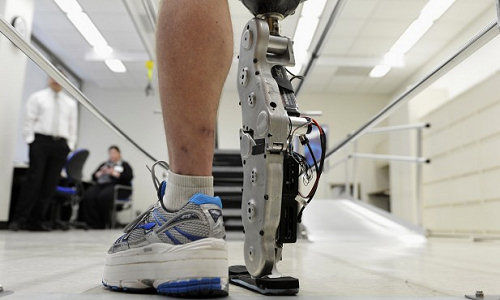The secret to building brain-controlled prostheses may be to ignore the brain entirely.In the past several years scientists have delivered a slew of advances in wiring prosthetic limbs directly to the brain. A number of studies have reported that severely disabled patients—or monkeys employed as research surrogates—have used bionic limbs controlled by thought to, say, pick up a cup or hold up a hand and give a high five.
Many of these devices have yet to become more than sophisticated laboratory showpieces that require constant fine-tuning to preserve a clear connection to the brain. Reliably reading the signals from electrodes implanted in the brain constitutes one of the grand challenges of neuroscience and biomedical engineering—and will occupy generations of researchers to come.
In the meantime, scientists and engineers have found a way to bridge the missing link. Instead of trying to decipher the cacophony of signals inside the brain, some researchers are configuring prostheses to take commands from the nerve endings left behind after an amputation.
Perhaps the best example to date is a robotic lower leg developed at the Rehabilitation Institute of Chicago. Scientists there fitted a cylindrical grid of 96 electrodes to the thigh of Zac Vawter, now 32 years old, after his lower leg had been amputated following a motorcycle accident in 2009. The electrodes in Vawter’s thigh picked up signals from his brain at the peripheral nerve endings, instructing the artificial limb to walk or even climb steps, the doctors reported in September in the New England Journal of Medicine.
To overcome the engineering challenge of teasing out strong, clear signals from the nerves left in Vawter’s leg, doctors attached the nerves that stimulate foot movements to residual muscles, which act as a natural signal booster. “Muscle will amplify the motor commands by about 1,000-fold,” says Todd Kuiken, director of the institute’s Center for Bionic Medicine.
Another new prosthesis used a similar peripheral link to relay signals the other way—from the limb to the brain—to convey a sense of touch. Researchers at Case Western Reserve University implanted tiny electrodes in the upper arm of an amputee and connected them to a robotic arm and hand. When sensors in the bionic hand detected pressure, the electrodes stimulated nerve endings to pass tactile information to the brain. The researchers tested the device by asking the patient to pull a grape off its stem while blindfolded. “He could hold it hard enough to pick up the grape but not so hard as to squish the fruit,” says Dustin Tyler, an associate professor of biomedical engineering at Case Western.
Direct brain-to-prosthesis links will still be needed someday for patients whose damaged spinal cords impede nerve signals to the limbs. Until then, plugging into peripheral nerve outlets may help some of the one million leg amputees in the U.S. go for a smoother stroll.
Story Source:
The above story is based on materials provided by Scientific American, Gary Stix.





